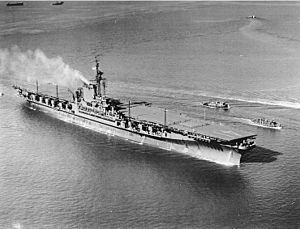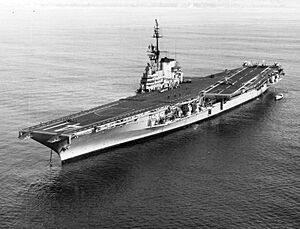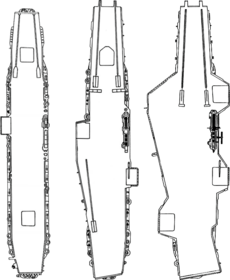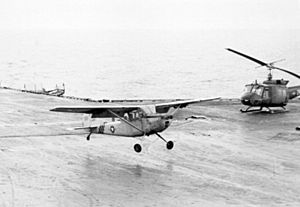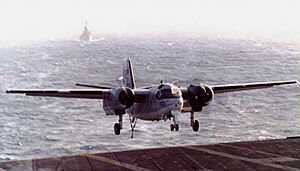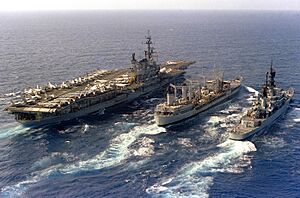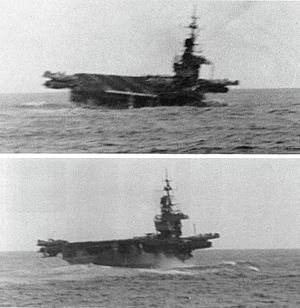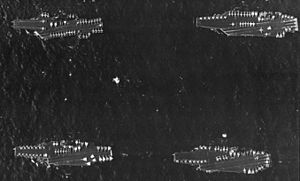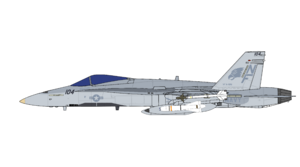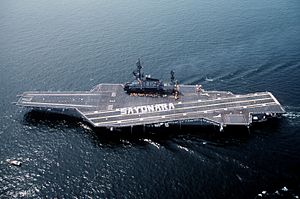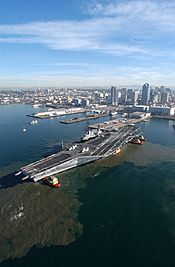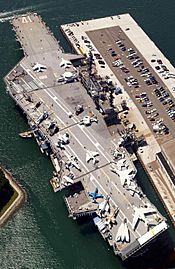USS Midway (CV-41) facts for kids
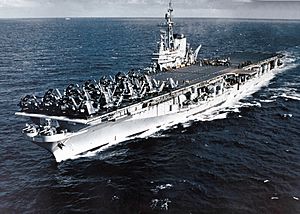
USS Midway steaming off the Firth of Clyde in September 1952.
|
|
| History | |
|---|---|
| Name | Midway |
| Namesake | Battle of Midway |
| Ordered | 1 August 1942 |
| Builder | Newport News Shipbuilding |
| Laid down | 27 October 1943 |
| Launched | 20 March 1945 |
| Sponsored by | Mrs. Bradford William Ripley, Jr |
| Christened | 20 March 1945 |
| Acquired | 1 September 1945 |
| Commissioned | 10 September 1945 |
| Decommissioned | 11 April 1992 |
| Reclassified |
|
| Stricken | 17 March 1997 |
| Nickname(s) | Midway Magic |
| Status | Museum ship at the USS Midway Museum in San Diego, California |
| Notes | Only carrier museum in the United States from WWII-era that is not of the Essex class |
| Badge | 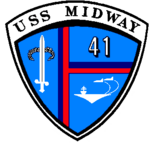 |
| General characteristics | |
| Class and type | Midway-class aircraft carrier |
| Displacement |
|
| Length | 1,001 ft (305 m) |
| Beam |
|
| Draft | 34.5 ft (10.5 m) |
| Propulsion | 12 boilers, four Westinghouse geared Steam turbines |
| Speed | 33 kn (61 km/h; 38 mph) |
| Complement | 4,104 officers and men |
| Armament |
|
| Armor |
|
| Aircraft carried | 137 theoretical, 100 (1940s–50s), 70 (Vietnam–retirement) |
The USS Midway (CV-41) was a famous aircraft carrier in the United States Navy. It was the first ship of its kind, known as the Midway-class. The Midway was put into service just eight days after World War II ended. For many years, it was the biggest aircraft carrier in the world. It was also the first U.S. carrier too large to fit through the Panama Canal.
This amazing ship served for 37 years. It took part in important events like the Vietnam War and Operation Desert Storm in 1991. After its long service, the Midway was taken out of active duty in 1992. Today, it is a popular museum ship in San Diego, California. You can visit it at the USS Midway Museum. The USS Midway is special because it's the only aircraft carrier from the World War II era that is now a museum, besides the smaller Essex-class carriers.
Contents
- The Midway's Journey: From War to Museum
- The Midway as a Museum Ship
- Awards and Honors
- See also
The Midway's Journey: From War to Museum
Building and Early Missions
The Midway began being built on October 27, 1943, in Newport News, Virginia. It was officially launched on March 20, 1945. The ship was then put into service on September 10, 1945. This was just after Japan surrendered, ending World War II.
After some initial training in the Caribbean Sea, the Midway joined the U.S. Atlantic Fleet. Its home base was in Norfolk, Virginia. In March 1946, the ship helped test new ways to rescue people and fly planes in very cold weather. This mission took place in the Labrador Sea.
In September 1947, something very unusual happened. A captured German V-2 rocket was launched from the Midway's flight deck. This was called Operation Sandy. It was the first time a large rocket was ever launched from a moving ship. The rocket lifted off but broke apart high in the sky.
Starting in October 1947, the Midway began its yearly trips to the Mediterranean Sea. There, it worked with the U.S. 6th Fleet. Between these trips, the ship trained its crew and was updated to handle newer, heavier aircraft.
Changes and Challenges in the 1950s
In June 1951, the Midway helped test new F9F Panther jets. During one test, a plane crashed on the deck, but the pilot survived. In 1952, the ship took part in NATO exercises in the North Sea. During this time, an angled flight deck was painted on the ship. This new design made it much safer and easier for planes to land. Because of this success, angled flight decks became standard on future aircraft carriers. On October 1, 1952, the ship's classification changed to CVA-41.
In December 1954, the Midway started a trip around the world. It sailed to Taiwan and became the first large carrier in the United States Seventh Fleet. During its time there, Midway pilots helped protect the evacuation of thousands of Chinese troops and civilians from the Tachen Islands. This happened during a tense time known as the First Taiwan Strait Crisis.
A Stand for Equality
In January 1955, the Midway docked in Cape Town, South Africa. At that time, South Africa had strict laws called apartheid, which separated people by race. Some U.S. senators were worried that the American sailors would be segregated. They asked the Navy to make sure all American service members were treated equally.
The captain of the Midway, Reynold Delos Hogle, made it clear. He said that while in port, the Midway was U.S. territory. He stated that all crew members, no matter their race, would be treated equally. There was no segregation for the Midway's crew in Cape Town.
Major Upgrades for the Midway
In June 1955, the Midway went to the Puget Sound Naval Shipyard for a big upgrade. This included adding a closed "hurricane bow" and an angled flight deck. It also received new steam catapults to launch planes. These changes made the ship much more modern and ready for new types of aircraft. The Midway returned to service in September 1957.
From its new home in Alameda, California, the Midway made yearly trips to the Western Pacific. It carried advanced jets like the McDonnell F3H Demon and Vought F-8 Crusader. In 1961, it sailed into the South China Sea during a crisis in Laos. In 1962, the Midway celebrated its 100,000th successful plane landing.
The Vietnam War Years
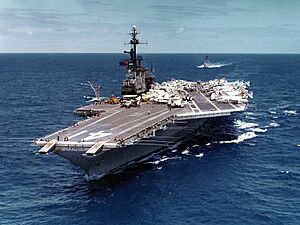
In March 1965, the Midway sailed to the Far East again. From April, its planes began flying missions against military targets in North Vietnam and South Vietnam. On June 17, 1965, two F-4B Phantom II jets from the Midway shot down two enemy MiG-17F planes. These were the first confirmed MiG kills for U.S. forces in the Vietnam War. A few days later, four of the Midway's A-1 Skyraider planes used an old World War II tactic to shoot down another MiG-17F.
The Midway returned to California in November 1965 for another huge upgrade. This project was very expensive. The flight deck was made much larger, and the angle of the landing area was increased. The ship also got new elevators and catapults. After the upgrades, the ship was put back into service in January 1970. However, the changes made the ship less stable in rough seas, which needed more adjustments later.
Return to Vietnam and a Special Award
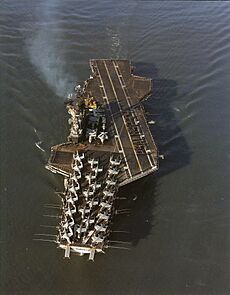
The Midway went back to Vietnam in May 1971. Its planes continued to fly missions. In April 1972, aircraft from the Midway and other carriers began dropping naval mines near North Vietnamese ports. This was to stop enemy ships from moving.
The Midway kept up its operations during Operation Linebacker in 1972. On August 7, 1972, a helicopter from the Midway rescued a downed pilot deep inside North Vietnam. This was a very dangerous mission, as they faced heavy enemy fire. By the end of 1972, the Midway's rescue team had saved 48 pilots.
In October 1973, the Midway moved its homeport to Yokosuka, Japan. This was a big deal because it was the first time a full carrier group was based in a Japanese port. This allowed sailors to live with their families and helped keep more carriers in East Asia.
For its brave service in Vietnam from April 1972 to February 1973, the Midway and its air wing received the Presidential Unit Citation. This is a very high honor. The citation praised the ship's "extraordinary heroism and outstanding performance of duty." Midway aircraft made both the first and the last air-to-air victories of the Vietnam War.
Operation Frequent Wind: A Daring Rescue
In April 1975, as the Vietnam War was ending, the Midway and other U.S. ships were sent to the waters off South Vietnam. They were there for Operation Frequent Wind, a mission to evacuate American personnel and Vietnamese people from Saigon. The Midway took on eight large U.S. Air Force CH-53 helicopters. These helicopters flew hundreds of people to the Midway and other ships in the South China Sea.
One incredible event happened on April 29, 1975. A South Vietnamese pilot, Major Lý Bửng, flew his small two-seat Cessna O-1 Bird Dog plane to the Midway. He had his wife and five children with him! He circled the carrier, trying to land. The ship's captain, Larry Chambers, made a quick decision. He ordered the crew to clear the flight deck. They pushed many expensive UH-1 Huey helicopters overboard to make space for Major Buang's small plane.
Despite difficult weather, Major Buang made a perfect landing. He became the first Vietnamese pilot to land a fixed-wing aircraft on an aircraft carrier. The crew of the Midway was so impressed that they started a fund to help his family settle in the United States. Major Buang's O-1 plane is now on display at the National Museum of Naval Aviation.
After the evacuation, the Midway helped move almost 100 captured Vietnamese aircraft to Guam. On June 30, 1975, the Midway's classification changed again, from "CVA-41" to "CV-41".
The Midway in the 1980s
In August 1976, the Midway led a U.S. Navy group near Korea. This was a show of strength after North Korean soldiers attacked U.S. Army officers. In 1979, the Midway was sent to the Indian Ocean due to the Iran Hostage Crisis. It helped maintain a strong American naval presence in the Persian Gulf region.
In July 1980, a merchant ship accidentally collided with the Midway. Two sailors were sadly killed, and three were injured. The Midway had minor damage. Later that year, the Midway spent 118 days straight in the Indian Ocean.
In March 1981, an A-6E Intruder plane from the Midway spotted a downed civilian helicopter in the South China Sea. Helicopters from the Midway quickly rescued all 17 people on board.
In March 1986, the last Navy F-4 Phantom II jet was launched from a carrier, happening on the Midway. These older jets were replaced by newer F/A-18 Hornets.
The Midway continued to serve in the Western Pacific. In 1986, it received special additions to its hull to make it more stable. However, these changes actually made the ship roll more in rough seas. This earned it the nickname "Rock'n Roll carrier." Despite this, the Midway survived a 26-degree roll during a typhoon in 1988, which was more than it was supposed to handle.
In October 1989, an F/A-18A Hornet from the Midway accidentally dropped a bomb on another ship, the USS Reeves, during training. This caused a hole in the Reeves' bow and injured five sailors.
A sad event happened on June 20, 1990. Two explosions on board the Midway caused a fire that lasted over ten hours. Two crew members were killed, and nine were injured; one of the injured later passed away. These sailors were part of the ship's firefighting team. Many people thought the ship would be retired because of its age and this accident. However, the Midway was kept in service for one more big mission.
Operation Desert Storm: The Final Battle
On August 2, 1990, Iraq invaded Kuwait. The U.S. and other countries began Operation Desert Shield to protect Saudi Arabia. On November 1, 1990, the Midway was in the North Arabian Sea, leading a group of warships. The United Nations gave Iraq a deadline of January 15, 1991, to leave Kuwait.
When Iraq did not leave, Operation Desert Storm began. On January 17, 1991, the Midway launched its planes for the first carrier strikes of the Gulf War. Its A-6E TRAM Intruder planes were among the first to attack Iraqi targets. They faced heavy anti-aircraft fire. No Midway aircraft were lost during these initial strikes.
Later, an F/A-18 Hornet from the Midway used a special television-guided bomb called a AGM-62 Walleye to destroy a building at an Iraqi naval base. On February 13, 1991, a pilot named LCDR Jeffery Ashby led a mission that destroyed an Iraqi Super Frelon helicopter. This helicopter had posed a threat to the U.S. carriers. This success allowed the Midway and other carriers to move closer to Kuwait.
Desert Storm officially ended on February 28, 1991. The Midway left the Persian Gulf on March 11, 1991, and returned to Japan.
Final Missions and Retirement
In June 1991, the Midway went on its last deployment. It sailed to the Philippines to help evacuate 20,000 military members and their families. This was after the Mount Pinatubo volcano erupted. The Midway and other ships transported these people to safety.
In August 1991, the Midway left Yokosuka, Japan, for the very last time. It sailed to Pearl Harbor, where another carrier, the USS Independence, took its place. The Midway then made its final journey to San Diego.
The Midway as a Museum Ship
The Midway was officially taken out of service on April 11, 1992, in San Diego. During this ceremony, a documentary film about carrier life was made. The ship was removed from the official Navy list on March 17, 1997.
On September 30, 2003, the former Midway began its trip from Washington state to San Diego, California. It was being prepared to become a museum and memorial. On January 10, 2004, the ship arrived at its final home in San Diego. It opened to the public as a museum on June 7, 2004. In its first year, the museum had almost 900,000 visitors, which was twice as many as expected!
The USS Midway Museum is a very popular attraction. On November 11, 2012, a college basketball game was even played on its flight deck. In July 2015, there was a small scare when smoke was reported on the ship, but no fire was found. In July 2025, a small fishing boat accidentally collided with the Midway, but there were no injuries or major damage.
Awards and Honors
The USS Midway received many awards and decorations during its long service. These honors recognize the bravery and excellent performance of its crew.
| Presidential Unit Citation | Joint Meritorious Unit Award | Navy Unit Commendation with three stars |
Meritorious Unit Commendation with two stars |
| Navy E Ribbon with wreathed Battle "E" device |
Navy Expeditionary Medal with three stars |
China Service Medal | American Campaign Medal |
| World War II Victory Medal | Navy Occupation Service Medal | National Defense Service Medal with two stars |
Armed Forces Expeditionary Medal with six stars |
| Vietnam Service Medal with four stars |
Southwest Asia Service Medal with two stars |
Humanitarian Service Medal | Sea Service Deployment Ribbon with sixteen stars |
| Republic of Vietnam Meritorious Unit Citation (Gallantry Cross) |
Republic of Vietnam Campaign Medal |
Kuwait Liberation Medal (Saudi Arabia) |
Kuwait Liberation Medal (Kuwait) |
See also
 In Spanish: USS Midway (CV-41) para niños
In Spanish: USS Midway (CV-41) para niños
- List of aircraft carriers
- List of aircraft carriers of the United States Navy


